Sheikh Abd el-Gurna (Egypt)
Tomb 1152 (Coptic hermitage)
Dates: 2007/2008 season — 9 December 2007 – 6 February 2008
Winter 2008 season — 3 November – 14 December
Team:
Tomasz Górecki, archaeologist, director (National Museum in Warsaw) (both seasons)
Eliza Szpakowska, archaeologist-egyptologist (PCMA)
Szymon Maślak, archaeologist (PCMA)
Zbigniew Polak, archaeologist (University of Warsaw)
Barbara Czaja-Szewczak, textiles expert and restorer (Wilanów Palace-Museum)
Urszula Iwaszczuk, archaeozoologist (freelance) (winter season)
Robert Mahler, anthropologist (PCMA)
Ewa Parandowska, wall painting restorer (National Museum in Warsaw)
Zuzanna Górecka, student-volunteer (winter season)
Łukasz Jarmużek, student of archaeology (University of Warsaw)
Joanna Michalska, student of archaeology (University of Warsaw)
Abu el-Abbas Selim Mohamed Kedr, SCA inspector
Amir Abdel Atef Ahmed Al Azab, SCA inspector (winter season)
The two months’ work at the Coptic hermitage in Sheikh Abd el-Gurna in the winter of 2007/2008 was devoted to various recording activities, completing the documentation of material from previous seasons and to conservation of the murals inside the hermitage. A study season was conducted in November-December 2008, mainly to examine the faunal remains collected over the previous seasons.
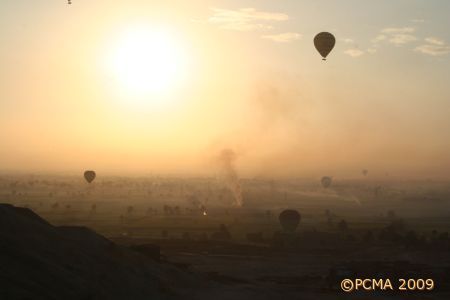
Sherds of domestic pottery from different layers were grouped by typological classes, mainly saqiyah-pots, storage vessels and other domestic jars, including many with painted decoration. Sherd recomposition in many cases helped to reconstruct the vessel form.
The osteological material collected during the excavations conducted on the site since 2003 were the subject of preliminary anthropological examination. The proportion of human to animal remains was estimated as 2:1. The bones collected from different locations, including six incomplete, mummified bodies proved to be a commingled set, containing the remains of a minimum 24 human bodies. At least six of these were not adults; most of the others seem to have been under 35 at the time of death.
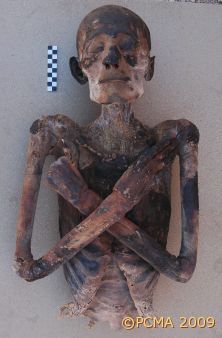
Upon review of the textiles collected in preceding seasons, they were found to be a mixed and incomplete set demonstrating considerable structural damage. Two groups were distinguished. Textiles from the Pharaonic-period mummies included fragmentary shrouds, bandages and binding tapes. Those from the Coptic period comprised small fragments of robes as well as linen and woolen yarn and threads. The latter actually suggests small-scale manufacturing of coarse textiles and tapes on site, a frequent occupation among the hermits. The yarn was twined and most probably dyed on the spot. The robes were mostly made of linen with trace evidence of wool. More than 170 textiles were registered with specialist description and photographic documentation entered in a database. They await conservation treatment in the future.
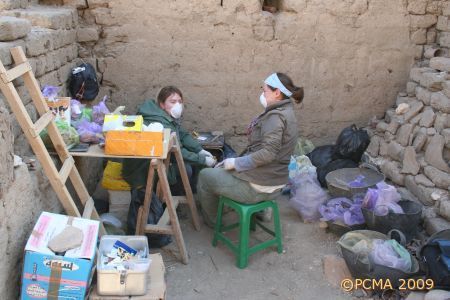
Analysis of the murals decorating the north wall of the rock-cut hermitage revealed from two to four painting layers, depending on the spot. Particular layers of the painting decoration were applied in different phases of occupation.
While a topographical total-station survey of the hermitage and its various features was being completed, the team carried out some limited excavations, uncovering two low walls of loose stones in the northern part of the hermitage. These walls had served as casing walls for the rock debris, the objective being to form an extended flat surface on the slope. Finds included large quantities of potsherds, glass vessel fragments and organic remains, as well as a few fragmentarily preserved ostraca. Further clearing work to the south of the tower uncovered the lowest of the terrace-steps leading to the hermitage. These steps were made of crushed mud brick mixed with potsherds and fragmented rock debris, tamped down to level the rock slope. Also in the southern part of the hermitage courtyard, explorations started on a mound of rock debris mixed with pieces of mud brick, big stones and innumerous potsherds. The accumulation was removed in two arbitrary layers, c. 30-35 cm thick, uncovering relics of mud-brick walls and a connected thin mud floor. Two sets of ostraca (altogether five) bound together with string lay undisturbed by one of the walls. They must have once been wrapped in a piece of cloth and tied, forming a bundle. This part of the hermitage will be explored in the coming season.
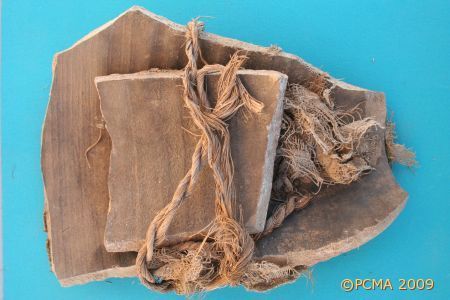
One of the finds was a small clay funerary cone (Diam. 9.2 cm, H. 12.7 cm) with the inscription of the tomb owner, one Ramose. The cone may have been brought by the monks from a nearby tomb (no. 103), possibly to be used as a convenient jar stopper. This secondary function of the cone is presumed from the findspot among several broken LR 7 amphorae.
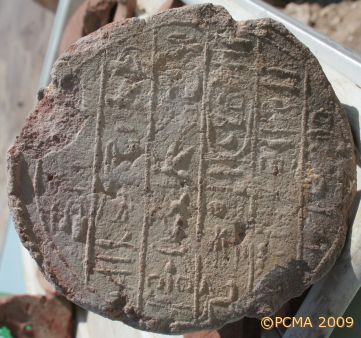
A small chamber excavated in the rock in the southern part of the enclosure was cleared of the rubbish and big blocks of stone filling it. The monks had adapted it by putting in the entrance a thin wall, just one mud-brick thick, with a narrow doorway only half a meter wide. They also built a small open hearth, apparently used only a few times, and a pot-stand made of the upper part of a broken amphora. On the outside, a high stone wall bordered the entrance to this chamber from the south, while a low wall of big stone blocks ran on the east. To the north, the courtyard space was cut off by the natural rock face. Insignificant quantities of pottery are also proof of the short-term occupation of this chamber.
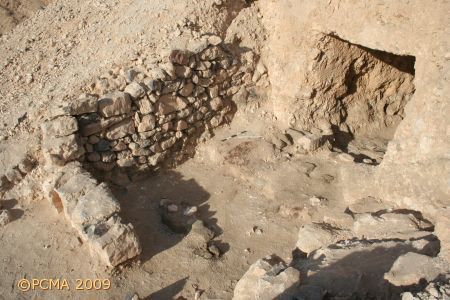
The excavated parts of the hermitage were swept with a metal detector, giving both expected and surprising results. Two iron awls, used either for plaiting or leatherwork, were registered by the detector in the corridor of the tomb, under the floor slabs. Most satisfyingly, however, the detector drew attention to a hollow in the rock surface of the hermitage courtyard. An iron pan was found there. The pan was 19.2 cm in diameter, 44 cm long with the handle, which was decorated with typical Coptic ornaments: cut images of bird, two fish and palm branches. This 7th-century piece resembles in shape and decoration the Late Roman pans known from two assemblages of metal vessels found in Thebes in the early 19th century.
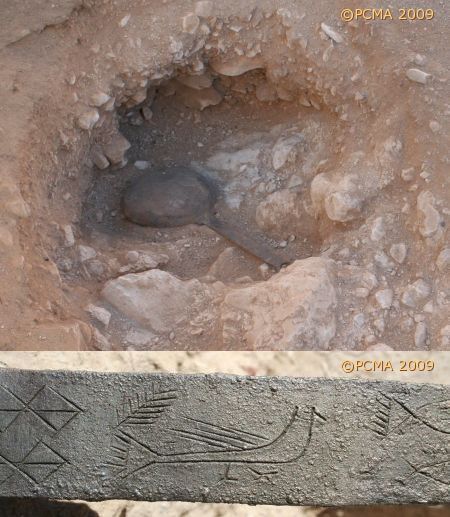
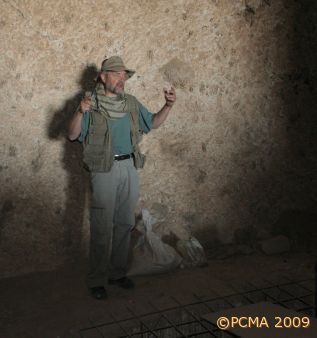
In the second season carried out late in 2008, the extensive rubbish dump on the rock slope below the tower and the courtyard of the hermitage was the focus of archaeological work. A few hundred potsherds were recovered, as well as organic remains, animal bones and wooden fragments. The assemblage also included 30 Coptic ostraca, written on sherds from mainly Egyptian amphorae, but a sizable group used sherds from imported amphorae with a cream-beige slip.
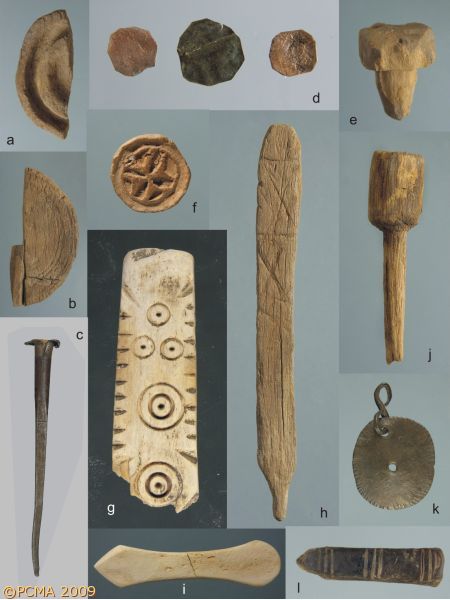
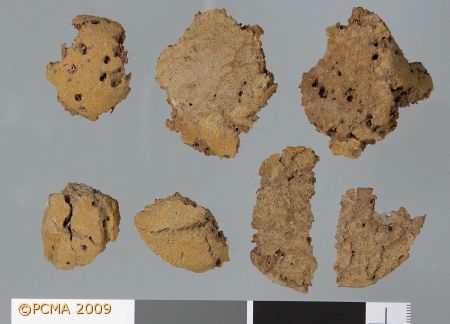
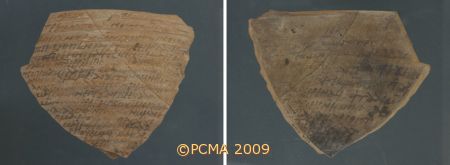
The dump also included many fragments of baskets and thick ropes, accompanied by numerous limestone chips with attached mud traces. It could be evidence of renovation works carried out inside the hermitage, which included replacing old floor tiles with new ones. The baskets and ropes are proof of how the material was removed from the hermitage. The finds reflect a fairly long period (6th-7th century) and are in a generally poor state of preservation.
A high bank of rock detritus in front of the entrance to a small tomb (of the Late Period?), 1.50 to 2.00 m high, was also explored. The monks who inhabited the tomb in the 8th century built the bank in order to be able to enter the tomb from the hermitage courtyard located 2 m below. The material in the bank included sherds of Egyptian amphorae and some plain ware pots. At the very bottom stood a damaged palm-leaf basket filled with fine rock detritus. It is tempting to think that the basket had been left there by workers employed on the “renovation” works inside the hermitage.
Investigations concerned the bench standing in the tomb corridor. Its walls were plastered of mud and once this coating was removed the fill inside was found to contain fine rock detritus and all kinds of rubbish: organic materials, scraps of textiles as well as a Hellenistic lamp and sherds from the upper part of a Roman amphora.
Faunal remains excavated on the site in 2003-2008 were examined. More than 90% of the assemblage (3238 fragments out of 3575) were identified by anatomical part and species. The predominant remains were those of mammals (97.3%), while bird bones were innumerous (2%), as were those of fish (0.6%); two fragments of shells were also noted. The assemblage was divided into post-consumption remains and remains not intended for consumption. The former were characteristically fragmented. The age of individuals represented in this group was very varied, the relatively biggest percentage, however, belonging to young sheep/goats (18.9%). This set covered 677 fragments. Ruminants predominated: cattle (54.2%) and sheep/goats (44.5%). Single bones of pig (1%) and camel (0.3%) were recorded. Cattle and sheep/goat bones represented all parts of the skeleton. Of the two camel bones one bore traces of chopping and filleting. Post-consumptional traces were noted also on a few bones of cattle and sheep/goats.
The other group included mostly whole bones, often larger parts of skeletons together with muscles and pieces of hide. These can be interpreted as carrion, animals that fell on the site already after its abandonment. Three species predominated among the 2472 fragments: fox (39.6%), dog (30.4%) and hyena (17.5%); other ruminants were also recorded (3.7%) including gazelle (1.7%) and antelope (0.8%), horse (2%), onager (0.7%), cat (0,04%) and small mammals (5.7%). Single bones of dog and hyena bore traces of contact with fire.
[Text based on original report by T. Górecki]
